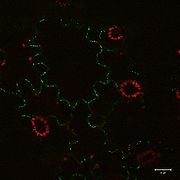
Movement Proteins
Encyclopedia

Plant virus
Plant viruses are viruses that affect plants. Like all other viruses, plant viruses are obligate intracellular parasites that do not have the molecular machinery to replicate without a host. Plant viruses are pathogenic to higher plants...
depends on its ability to move from the cell initially infected to neighbouring cells in order to spread infection. Unlike animal cells, plant cells have robust cell walls, which viruses cannot easily penetrate. Movement proteins are non-structural proteins encoded by many, if not all, plant viruses to enable their movement from one infected cell to neighbouring cells. Some plant viruses express more than one movement protein. The movement protein of Tobacco mosaic virus
Tobacco mosaic virus
Tobacco mosaic virus is a positive-sense single stranded RNA virus that infects plants, especially tobacco and other members of the family Solanaceae. The infection causes characteristic patterns on the leaves . TMV was the first virus to be discovered...
(TMV) has been most extensively studied. Plant viruses can also be transported over longer distances through the host plant in the vascular system via the phloem
Phloem
In vascular plants, phloem is the living tissue that carries organic nutrients , in particular, glucose, a sugar, to all parts of the plant where needed. In trees, the phloem is the innermost layer of the bark, hence the name, derived from the Greek word "bark"...
.
Plant virus movement between cells
Most plant viruses move between plant cells via plasmodesmataPlasmodesmata
Plasmodesmata are microscopic channels which traverse the cell walls of plant cells and some algal cells, enabling transport and communication between them. Species that have plasmodesmata include members of the Charophyceae, Charales and Coleochaetales , as well as all embryophytes, better known...
, pores between plant cell walls that allow the plant cells to communicate with each other. Plasmodesmata usually only allow the passage of small diffusible molecules, such as various metabolites. Neither virus particles nor viral genomic nucleic acid can pass through plasmodesmata unaided.
Function of movement proteins
Movement proteins modify the plasmodesmata by one of two well understood molecular mechanisms. The movement proteins of many plant viruses form a transport tubule within the pore of the plasmodesmata that allow the transport of mature virus particles. Examples of viruses that use this mechanism are Cowpea mosaic virusCowpea mosaic virus
Cowpea mosaic virus is a plant virus of the comovirus group. Infection of a susceptible cowpea leaf results in high virus yields . Its Genome consists of 2 molecules of positive-sense RNA which are separately encapsidated. Both RNA1 and RNA2 have a VPg at the 5'end, and polyadenylation at the...
(CPMV) and Tomato spotted wilt virus (TSWV). The second mechanism by which movement proteins work is by associating with and coating the genome of the virus, causing the ribonucleoprotein complexes to be transported through plasmodesmata into neighbouring cells. TMV's 30KDa
Atomic mass unit
The unified atomic mass unit or dalton is a unit that is used for indicating mass on an atomic or molecular scale. It is defined as one twelfth of the rest mass of an unbound neutral atom of carbon-12 in its nuclear and electronic ground state, and has a value of...
movement protein acts via this mechanism, although it may also have other roles in infection.

